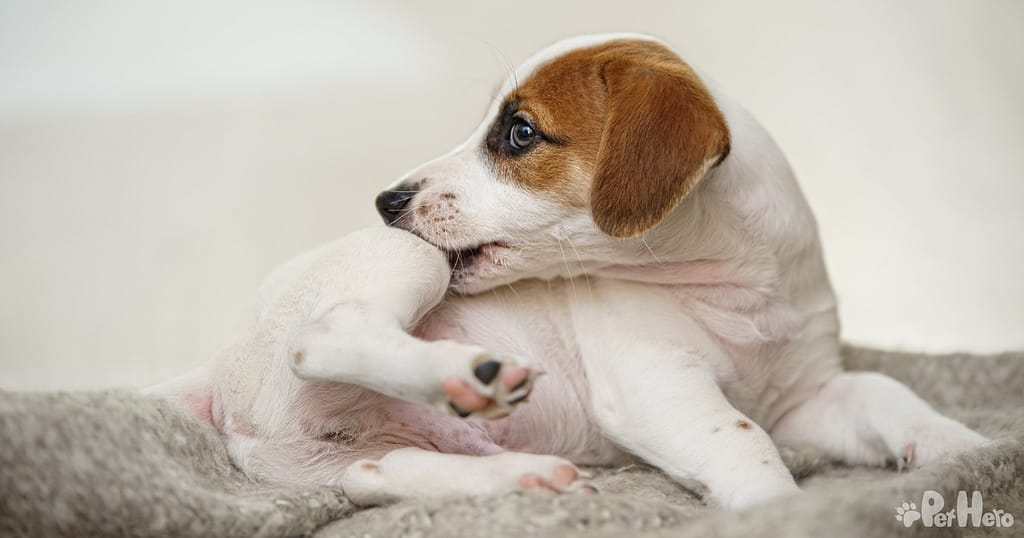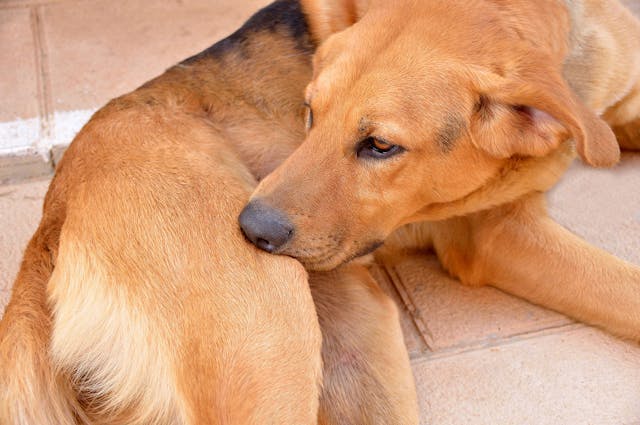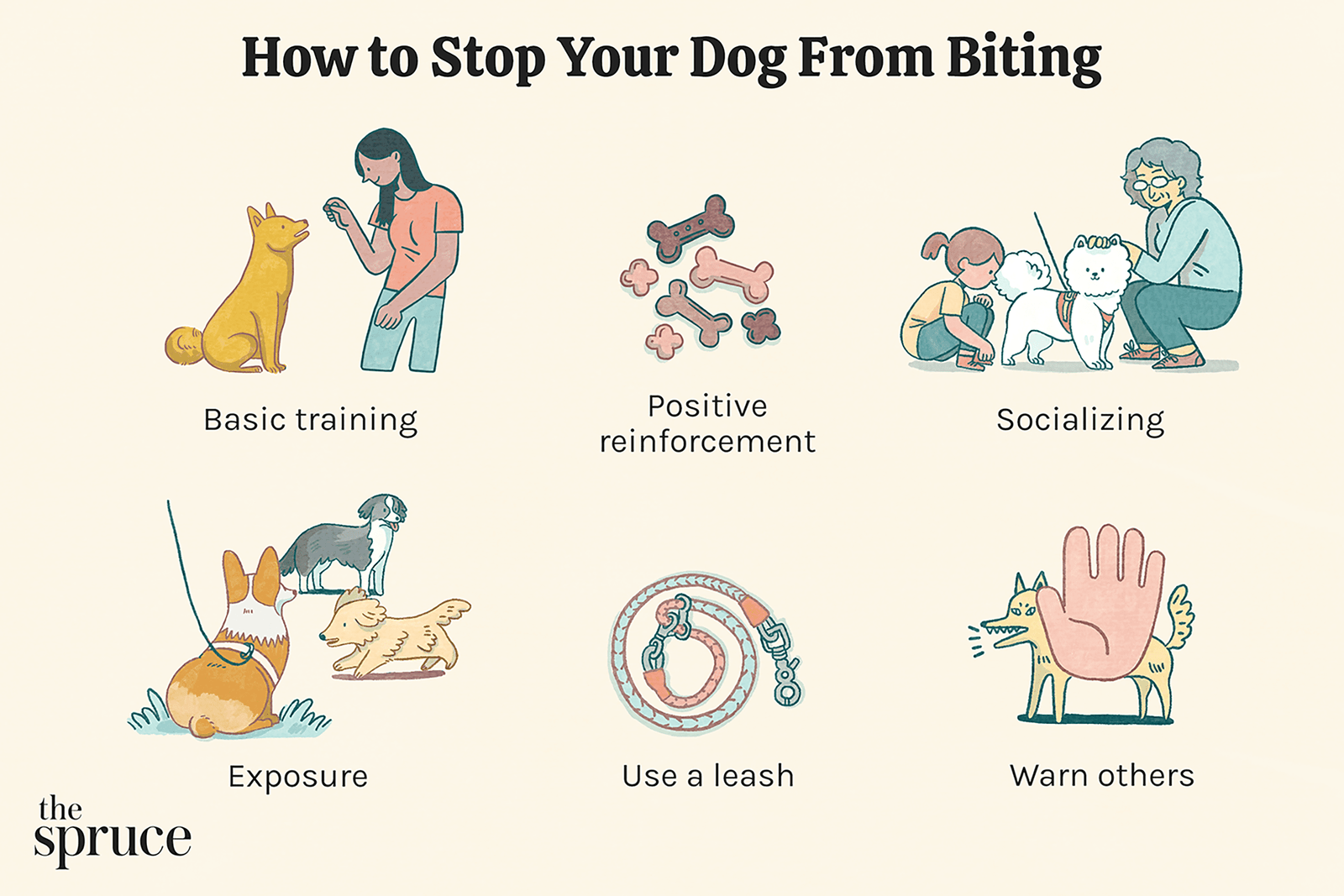How to Stop Dog from Biting Himself? To stop your dog from biting himself, identify the underlying cause, such as allergies or anxiety. Consult a veterinarian for proper diagnosis and treatment options.
Dogs may bite themselves for various reasons, including boredom, anxiety, or skin irritations. This behavior can lead to serious injuries and infections, making it crucial to address the issue promptly. Understanding why your dog engages in this behavior is the first step toward finding a solution.
Common triggers may include allergies, parasites, or stress. By observing your dog’s habits and environment, you can pinpoint the cause and take appropriate action. Creating a stimulating environment and providing appropriate distractions can also help. Always consult a veterinarian to explore medical treatments and ensure your furry friend stays healthy and happy.
Table of Contents
Recognizing The Signs Of Self-biting
Self-biting in dogs can lead to serious issues. Early detection is key. Recognizing the signs helps you intervene quickly. Understanding the behavior can improve your dog’s health.
Identifying Bite Marks
Look for visible signs on your dog’s skin. Bite marks can appear in various forms:
- Redness: Inflamed areas indicate irritation.
- Scabs: Healing wounds suggest previous bites.
- Hair loss: Missing fur may signal excessive biting.
- Bleeding: Open wounds can lead to infections.
Check these areas:
- Legs
- Stomach
- Back
- Tail
Behavioral Indicators
Self-biting often comes with noticeable behaviors. Watch for these signs:
- Excessive licking: A clear signal of discomfort.
- Whining or barking: Signs of distress or pain.
- Aggression towards paws: Targeting specific body parts.
- Restlessness: Unable to settle down.
Monitor your dog’s behavior closely. These indicators can help you identify the problem early.
Common Causes Of Canine Self-biting
Understanding why dogs bite themselves helps in finding a solution. Several factors lead to this behavior. Identifying the cause is crucial for effective treatment.
Skin Allergies
Skin allergies are a common reason for self-biting. Dogs may react to:
- Food ingredients
- Pollen
- Dust mites
- Fleas
Symptoms include:
- Red or inflamed skin
- Excessive scratching
- Hot spots
Visit a vet for a proper diagnosis and treatment plan.
Parasitic Infestations
Parasites can cause significant discomfort. Common parasites include:
- Fleas
- Ticks
- Mites
Signs of infestation are:
- Itching
- Hair loss
- Skin infections
Regular parasite control is essential for your dog’s health.
Psychological Factors
Sometimes, self-biting is due to stress or anxiety. Common triggers are:
- Change in environment
- Lack of exercise
- Separation anxiety
Watch for signs like:
- Excessive barking
- Aggression
- Destructive behavior
Consult a professional dog trainer or behaviorist for help.
Immediate Actions To Take
When your dog starts biting himself, quick action is essential. Addressing the issue right away helps prevent more damage. Here are two key areas to focus on: soothing the affected area and preventing further injury.
Soothing The Affected Area
First, check the area your dog is biting. Look for redness, swelling, or any wounds. Here are steps to soothe the affected area:
- Clean the Wound: Use mild soap and water.
- Apply a Cold Compress: This helps reduce swelling.
- Use Pet-Safe Ointment: Apply to prevent infection.
- Bandage if Necessary: This protects the area from further irritation.
Always monitor your dog after applying treatment. Look for signs of improvement or worsening conditions.
Preventing Further Injury
Stopping your dog from biting himself is crucial. Here are effective methods:
- Use an Elizabethan Collar: This prevents access to the affected area.
- Distract with Toys: Offer a toy to keep him occupied.
- Limit Activity: Restrict jumping or running until healed.
- Consult a Vet: Always seek professional advice for persistent issues.
Taking these immediate actions can help your dog heal quickly. Keep a close eye on his behavior and health.

Credit: pethero.co.za
Veterinary Diagnostics
Understanding why your dog bites himself is crucial. Veterinary diagnostics help identify underlying issues. These can be skin problems, allergies, or behavioral issues. A vet can provide a proper diagnosis to guide treatment.
Skin Scrapings And Allergy Testing
Skin scrapings and allergy testing are vital diagnostics. They help find skin infections or parasites. Here’s what you can expect:
- Skin Scrapings: This test checks for mites or fungal infections.
- Allergy Testing: This identifies specific allergens affecting your dog.
Both tests are quick and usually painless. Your vet will collect samples and analyze them under a microscope.
Behavioral Assessment
A behavioral assessment evaluates your dog’s mental state. It identifies stressors causing self-biting. Key points include:
- Observation: Watch your dog’s behavior in different settings.
- History: Discuss any recent changes in your dog’s environment.
- Triggers: Identify what makes your dog anxious or stressed.
Veterinarians may recommend training or behavior modification. This helps reduce anxiety and prevent self-biting.
Medical Treatments Available
Dog biting can stem from various medical issues. Treatment often involves medications. These medications help relieve discomfort and treat underlying conditions. Understanding treatment options is crucial for your dog’s health.
Topical And Oral Medications
Medications can be divided into two main types: topical and oral.
- Topical Medications: Creams and ointments applied directly to the skin.
- Oral Medications: Pills or liquid given by mouth to address internal issues.
Topical treatments often include:
- Hydrocortisone cream for inflammation
- Antibiotic ointments for infections
- Moisturizers for dry skin
Common oral medications may include:
- Antihistamines for allergies
- Anti-inflammatories for pain
- Antibiotics for bacterial infections
Allergy Management
Allergies can cause significant discomfort for dogs. Identifying and managing allergies is essential.
| Allergy Type | Common Symptoms | Management Options |
|---|---|---|
| Food Allergies | Itching, digestive issues | Special diet, hypoallergenic food |
| Environmental Allergies | Itching, sneezing | Allergy medications, avoiding allergens |
| Flea Allergies | Itching, skin infections | Flea control, regular grooming |
Always consult a veterinarian for the best allergy management plan.

Credit: squishface.com
Behavioral Modification Techniques
To stop your dog from biting himself, use effective behavioral modification techniques. These methods help reshape your dog’s actions. Focus on positive reinforcement and stress reduction. Both techniques create a happier, healthier pet.
Positive Reinforcement Training
Positive reinforcement training rewards good behavior. This approach motivates your dog to stop biting. Here are some key points:
- Use treats for good behavior.
- Offer praise when your dog avoids biting.
- Provide toys to redirect biting urges.
Follow these steps:
- Observe your dog’s behavior.
- Identify triggers for biting.
- Reward your dog when he avoids biting in those situations.
Keep training sessions short and fun. Consistency is crucial for success. Celebrate small victories to encourage progress.
Stress Reduction Strategies
Stress can lead to self-biting. Reducing your dog’s stress is important. Consider these strategies:
| Strategy | Description |
|---|---|
| Exercise | Regular walks and playtime help reduce anxiety. |
| Calm Environment | Create a quiet space for your dog to relax. |
| Routine | Establish a daily routine for meals and play. |
Use calming products like anxiety wraps. Natural supplements may also help. Consult your vet before trying new products. Monitor your dog’s behavior closely for changes.
Home Remedies And Preventive Measures
Addressing a dog’s self-biting behavior requires effective home remedies and preventive measures. These methods can help soothe your dog and prevent future issues. Here are some natural and practical options to consider.
Natural Soothing Solutions
Many natural remedies can calm your dog and reduce their urge to bite themselves. Here are some effective solutions:
- Aloe Vera Gel: Apply a small amount to irritated skin.
- Chamomile Tea: Brew, cool, and use it as a rinse.
- Oatmeal Baths: Soak your dog in oatmeal-infused water.
- Coconut Oil: Massage onto dry or flaky skin.
- Fish Oil Supplements: Promote skin health and reduce inflammation.
Always test a small area first. Monitor your dog for any reactions. Consult your vet if symptoms persist.
Protective Garments
Using protective garments can prevent your dog from biting itself. Here are some options:
| Garment Type | Purpose |
|---|---|
| Elizabethan Collar | Prevents access to the skin. |
| Dog Onesies | Cover the body to stop biting. |
| Specialized Wraps | Provide comfort and prevent scratching. |
Ensure the garment fits well. Check for comfort and mobility. Remove the garment for short periods to allow your dog to relax.
Long-term Strategies For Prevention
Preventing a dog from biting himself requires consistent, long-term strategies. Focus on health, care, and environment. Implementing these methods can lead to positive changes. Here are some effective approaches:
Diet And Nutrition
A balanced diet plays a crucial role in a dog’s health. Poor nutrition can cause skin issues and allergies. Consider these points:
- Choose high-quality dog food.
- Avoid fillers and artificial additives.
- Include omega fatty acids in their diet.
- Consult a vet for specific dietary needs.
Monitor your dog for any food allergies. Switching to a hypoallergenic diet can help. Always provide fresh water and avoid overfeeding.
Regular Grooming And Care
Regular grooming keeps your dog’s coat healthy. It helps remove dirt and dead skin. Follow these grooming tips:
- Brush your dog’s fur weekly.
- Bathe your dog as needed.
- Check for parasites regularly.
- Trim nails to prevent discomfort.
Pay attention to skin conditions. Visit the vet for persistent issues. A clean dog is less likely to bite himself.
Environmental Enrichment
Provide a stimulating environment for your dog. Boredom can lead to self-biting. Implement these ideas:
- Offer interactive toys.
- Schedule daily walks and playtime.
- Introduce puzzle feeders.
- Rotate toys to keep them interesting.
Encourage socialization with other dogs. A busy and happy dog is less likely to bite himself. Create a safe space filled with toys and activities.
When To Seek Professional Help
Noticing your dog biting himself often? It can be a sign of stress or health issues. Understanding when to seek professional help is crucial for your dog’s well-being. Early intervention can prevent further problems.
Consulting A Dog Behaviorist
Consult a dog behaviorist when:
- Your dog bites himself excessively.
- Self-biting leads to injuries or infections.
- Home remedies fail to improve the situation.
A dog behaviorist can:
- Identify the root cause of the behavior.
- Offer tailored training plans.
- Teach you effective management strategies.
Recognizing Compulsive Disorders
Some dogs develop compulsive disorders. Signs include:
- Repeatedly biting specific body parts.
- Spending excessive time grooming.
- Displaying anxiety in other situations.
Seek professional help if you notice these behaviors. A vet can assess for underlying health issues. Early diagnosis can lead to better outcomes.

Credit: wagwalking.com
Success Stories: Turning The Tide On Self-biting
Many dog owners face the challenge of their pets biting themselves. This behavior can stem from anxiety, boredom, or skin issues. Fortunately, numerous success stories showcase effective methods. These inspiring cases encourage others to seek solutions for their furry friends.
Case Studies
Here are some remarkable case studies that highlight successful interventions:
| Dog Name | Breed | Issue | Solution | Outcome |
|---|---|---|---|---|
| Buddy | Labrador | Self-biting due to anxiety | Consistent training and calming supplements | Reduced anxiety, stopped biting |
| Daisy | Poodle | Itchy skin | Change in diet and vet visit | Healthy skin, no more biting |
| Max | Beagle | Boredom | Increased exercise and toys | Happier dog, no biting |
Owner Testimonials
Real-life experiences from dog owners shed light on successful strategies:
- Sarah: “Buddy’s anxiety was tough. Training helped him feel secure.”
- James: “Daisy’s skin issues were solved with a vet’s help. She’s happier now.”
- Linda: “Max loved his new toys. He stopped biting after more playtime.”
Each story emphasizes the importance of understanding the root cause. Solutions vary based on individual needs. With patience and effort, change is possible.
Frequently Asked Questions
Why Does My Dog Bite Himself?
Dogs may bite themselves due to allergies, stress, or boredom. Skin irritations, parasites, or infections can also trigger this behavior. Observing your dog’s habits can help identify the cause. Consulting a veterinarian is essential for a proper diagnosis and treatment plan.
How Can I Prevent My Dog From Biting?
To prevent your dog from biting, ensure they receive regular exercise and mental stimulation. Providing toys and engaging activities can help redirect their energy. Additionally, establish a consistent routine and practice positive reinforcement for desired behaviors. Always consult a vet for underlying health issues.
What Are The Signs Of A Stressed Dog?
Common signs of a stressed dog include excessive barking, pacing, and destructive behavior. Other indicators can be excessive grooming, hiding, or changes in appetite. Pay close attention to your dog’s body language. Identifying these signs early can help you address their needs effectively.
When Should I See A Vet For Biting Issues?
You should see a vet if your dog’s biting becomes excessive or if it leads to injuries. Also, consult a vet if there are visible skin issues or if the biting is frequent. Early intervention can prevent more serious health problems and behavioral issues.
Conclusion
Stopping your dog from biting himself is essential for their health and happiness. Regular vet check-ups can help identify underlying issues. Creating a stimulating environment and providing proper training can also make a difference. With patience and care, you can improve your dog’s well-being and strengthen your bond with them.



